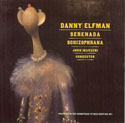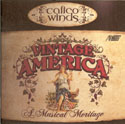

CD Reviews - 2006
Music by Danny Elfman
8 Tracks (Playing Time = 46:11)
Includes “Improv for Alto Sax” (1 track: 2:56)
Produced by Danny Elfman.
Movement 5 lyrics by Claudia Brant and Livia Corona. Orchestrated by Steve Bartek and Edgardo Simone. Featuring the Hollywood Studio Symphony Orchestra and Chorus conducted by John Mauceri. Also features soprano Elissa Johnston and alto saxophonist Dan Higgins. Recorded by Armin Steiner. Mixed by Dennis Sands and Armin Steiner at the Eastwood Scoring Stage at Warner Bros.. Pro-Tools and music editing by Shie Rozow. Mastered by Patricia Sullivan at Bernie Grundman Mastering. Recorded at the Newman Scoring Stage at Fox Studios. Cover and booklet art by George Condo.
Sony Classical 82876-89780-2
Rating: ****
This may be the first time a piece of music had its own website (though in truth it is really just a page inside of Sony’s web pages). Elfman’s first concert work, commissioned by the American Composers Orchestra, receives its premiere recording here conducted by John Mauceri. The piece premiered at Carnegie Hall in February, 2005, and later was tracked into the IMAX film DEEP SEA 3D. That may very well explain the orchestration credits here. It is perhaps fitting that Elfman can join the list of Hollywood film composers with concert pieces. The disc also includes a brief “Improv for Alto Sax.” The main complaint one can level off the start is that filling out the disc with performances of other Elfman pieces from this ensemble would have been welcome. It might have at least introduced classical music fans to some of Elfman’s greater film accomplishments. But perhaps that can be a detraction in the classical bin these days. “ Serenada Schizophrana” is filled though with the musical gestures and thematic styles that Elfman fans have come to love over his long film music career.
The work is scored for a large orchestra with chorus (in movement five). The opening movement, “Pianos,” unfolds with a small motivic idea, intriguingly developed and which grows in intensity. The sound of the movement occupies the same realm as John Adams post-minimalist symphonic works with dramatic writing that owes a nod or two to Herrmann. Though Elfman lists some of his “influences” in the notes, this piece is not so much one large mess of styles as it is a piece of Elfman’s orchestral style. There are moments in “Pianos” that could have easily have come from a Burton underscore. The movement itself is in a semi-arch form with motivic variations that creates coherency towards its conclusion by the return of the opening material.
“Blues Strings” (movement two) continues the idea of smaller motivic layers with arching themes. Here Herrmann’s sound is quite apparent but this is really a musical sound that one finds in much of Elfman’s darker dramatic writing mixed in with a little Shostakovich of the string quartets. “A Brass Thing” is like a bizarre tango-tinged brass number with a lot of sass. It sounds like something straight out of Elfman’s BATMAN scores or like a lost piece from THE NIGHTMARE BEFORE CHRISTMAS or CORPSE BRIDE. But it too moves through different brass ideas both jazz and orchestral with nice little woodwind interludes. Here again, while one could spend time trying to disentangle the various “influences,” the music sounds like one would expect from Elfman in all his musical guises and styles. This movement is probably the closest to prior film outings. The wordless chorus, always a part of Elfman’s film music, does not appear until the fourth movement. Here is a brief scherzo that loses steam but that sets up the fifth movement, “I Forget.” This is perhaps worth the price of the disc alone. Again, there is a lot of Elfman’s style on raw display here funneled through the update sound of Orff. The movement would be interesting to hear in a concert hall to see how well the choir cuts through the texture here which is filled with a variety of mallet percussion sounds. The effect is a subtler sound from that used in his score to PLANET OF THE APES. The fifty second “End Tag” is really underwhelming. The piece needed something a little more to round it off than this which feels like an afterthought. It might even be a thought to move the choral movement to the end and round off the piece that way.
The work is quite accessible on its own merits. It is not quite in the “Concerto for Orchestra” vein as say Bartok’s or even Lutoslawski’s pieces. By giving his piece the designation as a “Serenade” Elfman can avoid having to worry about longer connections between movements thematically or even harmonically. Instead, we have a wonderfully entertaining piece by one of our great American film composers. The movements that work best are those that do seem to flow organically out of their musical ideas instead of sounding like suites from top drawer film cues. In these cases (movements 1, 2, 5, and 6) we hear the work of a composer trying his hand at “concert” absolute music. These movements can be cause for encouragement that we may here other larger scale orchestral pieces from Elfman in the future.
The brief “Improv for Alto Sax” is beautifully performed by Dan Higgins. It comes from the same fabric as the serenade and sounds more like a movement that just never went anywhere and was truncated and recorded because there was time. There is nothing there to warrant it being picked up for solo performers elsewhere so this may be the one and only recording of it. As “marginalia” though it is still expertly crafted and enters as one of many similar type pieces that appears in every composer’s catalogue.
“ Serenada Schizophrana” is like a large tone poem of sorts that works well with the imagery of Condo’s art. One could easily see these images being projected during a performance of the piece in a multi-media presentation. The performance here is top notch but the audio has the kind of acoustic typical of a Hollywood score than the often warmer ambience of a concert hall. That will not be a detraction to film music fans who are used to this acoustic neither should it be off putting to those vaguely familiar with that recording style.
The website, http://www.serenadaschizophrana.com, features audio clips from the piece as well as an English translation of the text. The booklet, somewhat in keeping with the schizophrenic theme perhaps, folds out lengthwise to read the brief composer note and the Spanish text. In keeping with the Hollywood musician’s agreement, all performers are listed as well. This is interesting because historically, we will be able to see, if this piece is recorded in future, how musicians essentially familiar with Elfman’s music from their many film score recordings compare to any other orchestra. My guess is that a recording in the more traditional “classical” sense will also be a worthy addition to the discography at some later date. The art work, by George Condo, is like Paul Klee filtered through the imagination of Tim Burton. Several of these pieces appear on the reverse side of the booklet and on the back cover of the case.
This is a “hybrid” recordings playable on traditional CD players and those equipped with “Super Audio” surround sound.
--Stephen A. Kennedy, 3 October 2006
Comments regarding this review can be sent to this address: stev4uth@hotmail.com
Music by William Mason, Edward MacDowell, Daniel Gregory Mason, Arthur Farwell, William Grant Still, Scott Joplin, David B. Chadwick, John Philip Sousa
24 Tracks (Playing Time = 60:54)
Tracks:
1. Dance Antique, Op. 38 -- William Mason, arr. Harry Gee/trans. CW
2-7. Fireside Tales, Op. 61 -- Edward MacDowell, arr. Ronald Hess
8-9. Divertimento, Op. 26b -- Daniel Gregory Mason
10. Prairie Miniature -- Arthur Farwell
11-15. Miniatures -- William Grant Still, arr. Adam Lesnick
16-18. Folk Suite No. 4-- William Grant Still, arr. Adam Lesnick
19-20. Two Rags -- Scott Joplin, arr. Arthur Frackenpohl
21-23. Sea Sketches -- David B. Chadwick
24. The Stars and Stripes Forever -- John Philip Sousa, arr. Bill Holcombe
Performed by the Callico Winds (Eileen Holt Helwig, flute & piccolo; Rong-Huey Liu, oboe & English horn; Rachel Berry, horn; Kathryn Nevin, clarinet; Theresa Treuenfels, bassoon)
Recording and Editing Engineer: Steven Schmidt. Mastering Engineer: Michael McNerney. Graphic Design: Bory Chung & Sean Starkweather. Recorded at Pollack Theatre, Palm Desert, California.
Albany CD TROY 693
Rating: ***1/2
This is a pleasant hour long journey back to an era when lighter wind music was popular. Half the composers on this CD are well known--namely: MacDowell, Still, Joplin and Sousa). The others are not so well known: W. and D.G. Mason, A. Farwell, D.B. Chadwick. Of the nine compositions featured on the CD, six of them are arrangements from works originally written for piano or orchestra. Such arrangements are common today, yet there remains much original wind music from America's past that still needs to be explored to see if any hidden gems might be stored away in some archive or grandma's attic truck.
The CD opens with a snappy little "Dance Antique" piece (2:44) by William Mason, arranged by Harry Gee, and transcribed by the Callico Winds. The "Fireside Tales" by MacDowell consist of six movements and are full of Late Romantic expressiveness. The wind arrangements by Hess are even more diverse than the original piano versions.
Probably the highlights of this CD are the two works by Still: "Miniatures" and the shorter "Folk Suite No. 4." The first one has a series of mostly familiar tunes done up in a delightful manner. The first tune is the old cowboy song, "I Ride an Old Paint" (3:48), and it brims with sly touches and subtle developments while the familiar melody remains prominent. The second tune, "Adorido Mexico" (2:00), is equally charming in its exotic flavor. The third tune is the bluesy spiritual, "Jesus is a Rock in the Weary Land" (2:48); the fourth is "Yaravi Peru" (2:15); and the fifth is the children's song, "A Frog Went A-Courtin'" (1:34).
The two rags by Scott Joplin ("The Cascades" and "Maple Leaf Rag") are fine in these wind versions, but the piano versions are still vastly superior. The "Sea Sketches" by D.B. Chadwick are very "seaworthy" (excuse the pun). Chadwick (b. 1946) is the only contemporary composer featured. His delightful settings of three sea chanteys fit in nicely with the rest of the music on the CD. The last track offers a spirited arrangement of Sousa's best known march (3:02) and is well arranged and performed.
The Callico Winds are a well balanced group of musicians who provide convincing performances of each selection on the CD.
The CD booklet has helpful notes on the music but they are uncredited. Perhaps it was a group research effort by the Callico Winds. The notes explain that the word "meritage" combines "merit" with "heritage" and is borrowed from a winemaking term for excellence from The Meritage Association (www.meritagewine.org). The design for this booklet is very tasteful and appealing, looking like a well-aged old book and having some attractive old prints as well.
With a few slight reservations, this is a highly enjoyable program of music for wind instruments.
It fully lives up to its title of providing appealing music from "Vintage America."
--Roger L. Hall, 12 December 2006
Comments about this review may be sent to: American Music Preservation
Please help support
American Music Preservation.com
Use this handy Search Box for your purchases...
Home page: Classical Composers
© 2006 PineTree Productions. All Rights Reserved.








